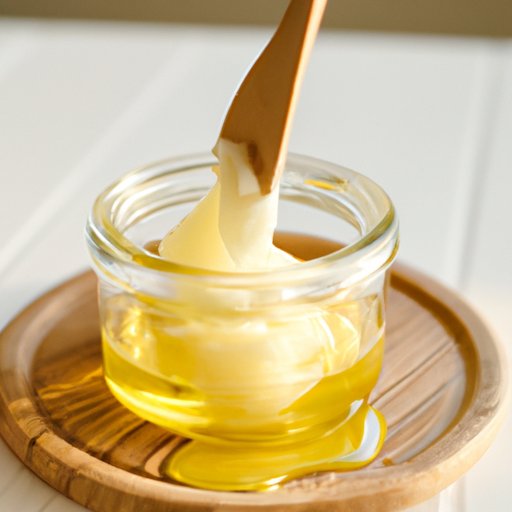
I. Introduction
For individuals with lactose intolerance, consuming dairy-based products can often lead to uncomfortable digestive symptoms. Fortunately, ghee offers a potential solution. In this article, we’ll explore the potential benefits of using ghee as a lactose-free alternative to traditional dairy products. From explaining its science to offering recipe suggestions, we’ll cover all you need to know about cooking with ghee.
II. Exploring the Potential Benefits of Ghee for Lactose Intolerant Individuals
Ghee is a type of clarified butter that originated in India. It’s made by simmering butter until the milk proteins and water separate from the fat and are then skimmed off. This process results in a final product that is lactose-free and suitable for those with lactose sensitivities. The butterfat in ghee is also more concentrated than butter, giving it a rich, nutty flavor.
Scientists have found that, unlike other dairy products, ghee is free of lactose because lactose is water-soluble, and it’s removed during the production of ghee. Instead of lactose, ghee is packed with healthful vitamin A, D, and E. As a result, ghee can be a great alternative for those who are lactose intolerant.
Moreover, Ghee is also rich in short-chain and medium-chain fatty acids. These types of fat are easy to digest and provide a quick burst of energy to the body. As ghee is easy to digest, it can be beneficial for people with less-than-ideal gut health.
III. Comparing Ghee to Other Dairy Products for Those with Lactose Sensitivities
Comparatively, ghee contains zero percent lactose. Whole milk, and regular butter contain approximately 5% lactose per gram serving. Despite its lack of lactose, some people with dairy allergies may still not be able to consume ghee. However, for those who tolerate it, ghee is a great alternative to many other dairy products.
Ghee is highly versatile and provides many other benefits, such as high smoke point, making it ideal for cooking without burning. It works well with almost any cooking method, including sautéing, frying, and baking. Additionally, ghee has a longer shelf life than butter and can be stored without refrigeration, making it a more cost-effective option in the long run.
There are a few examples where using ghee may be a great choice for those with lactose intolerance. For example, adding ghee instead of regular butter to toast or using ghee instead of cream to enrich soups or gravies.
IV. A Beginner’s Guide to Cooking with Ghee for Those Who Are Lactose Intolerant
Using ghee instead of other dairy products can be a little overwhelming, especially for those who are new to cooking with it. To get the most out of cooking with ghee:
- Allow ghee to warm up to room temperature before cooking.
- Clarified butter has a higher smoke point than regular butter, which means it’s less likely to burn when exposed to high heat
- Replace butter with ghee in a 1:1 ratio when using it in recipes
- For recipes that call for butter, you can also use ghee as a 1:1 substitute to reduce lactose intake
Additionally, unlike regular butter, ghee has a longer shelf life and does not require refrigeration.
Finally Here are a few recipes to try:
- Ghee Roasted Vegetables Recipe
- Ghee Rice Recipe
- Greek Yogurt Bowl with Kiwi and Pomegranate using Ghee instead of Greek Yogurt
V. Discussing the Health Benefits of Ghee and How It May Help with Lactose Intolerance Symptoms
Ghee provides a host of health benefits beyond being lactose-free.
Firstly, ghee can improve digestion by increasing enzymes that aid in digestion by releasing bile. Included in ghee is butyric acid, which benefits gut bacteria, improves digestion and bowel function, lower inflammation, and improve insulin resistance.
Moreover, ghee is also a great source of conjugated linoleic acid (CLA), an essential fatty acid that has been linked to improving cardiovascular health and reducing inflammation.
Finally, given its easy-to-digest properties, ghee may help alleviate lactose intolerance symptoms for those who cannot tolerate traditional dairy products. Ghee can replace butter in recipes, making it easier to incorporate this healthier alternative into your diet and find relief from digestive problems, swelling, and bloating.
VI. Addressing Common Misconceptions About Ghee and Lactose Intolerance
There are some common myths about lactose intolerance and ghee consumption that we need to dispel.
Firstly, ghee is lactose-free, so it’s a great option for individuals with lactose intolerance or sensitivity.
Secondly, some people think ghee is high in calories and fat and should not be consumed in large amounts. However, most of the fat in ghee is composed of short-chain and medium-chain fatty acids, which are essential for providing energy to the body. In moderation, ghee can be a healthy addition to any diet.
VII. Conclusion
To conclude, when it comes to lactose intolerance, ghee offers a lactose-free option that can improve digestion and overall health. It’s versatile, has a long shelf life, and can replace butter in recipes. Use our beginner’s guide to start cooking with ghee, try out our recipe suggestions and enjoy the health benefits it provides.





